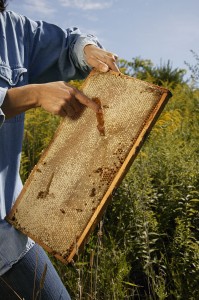
SUMMER ALERT !
During the hot temperatures of summer you may notice the texture and consistency of your raw honey may change. It may become softer or change color. In order to retain the original consistency you may wish to store the honey in the refrigerator or ever in the freezer.
Q: What are the speckled particles I see in the layer on top of the honey?
A: What you see upon opening the jar is a layer of honeycomb mixed with bits of propolis and pollen. The honeycomb is lighter than the honey and so it rises to the top during crystallization with some pollen and propolis adhering to it. All are naturally occurring and beneficial hive products.
Q: Why is the honey white and solid instead of amber and liquid?
A: This is because the honey is not heated and it crystallizes (hardens) this way naturally. This is what happens naturally in the hive. Just like a cooked vegetable will be different in color, flavor, texture, and nutritional value from a raw vegetable, the same is true for raw honey vs. heated (cooked) honey.
Q: What are the benefits of eating raw honey?
A: The benefits are many, but mostly, the original hive nutrients are left intact. The minerals, live enzymes, vitamins, and antioxidants are not destroyed by heating. University of Illinois food scientists discovered that honey packs the same antioxidant punch as spinach and strawberries. Studies reveal that eating 2-4 Tbs. of honey daily can raise antioxidant levels in your bloodstream by 10%. The antioxidants stop cholesterol from sticking to blood vessel walls and help prevent buildup of plaque in arteries. Honey can stimulate B-lymphocytes and T-lymphocytes to multiply, thus boosting the immune system. Honey has been used for centuries to improve poor digestion, oral health, sore throat, cough, allergies, burns, wounds, scars and rashes. Honey is more effective than antibiotic ointments on a cut or burn. It reduces infection, speeds healing and reduces scarring. In one study 87% of patients with honey-coated burns healed completely within 2 weeks, compared to just 10% of those treated with standard Rx, silver sulfadiazine. Also, the honey destroyed 100% of the bacteria that cause infection. Eating 1-2 Tbs. of honey helps people exercise harder and longer and keeps them from feeling sluggish afterwards. Honey is antibacterial, anti-microbial, and anti-irritant.
Q: Why is Bee Pollen Beneficial?
A: There are 22 amino acids in bee pollen. Weight for weight it is higher in protein than steak, eggs or cheese, without the fat. It is also rich in antioxidants, vitamins, enzymes, and minerals. Bee pollen is recognized as an immune system enhancer for its ability to strengthen the body against viral infections. It is effective in relieving fatigue, improving concentration, the treatment of asthma and allergies. USDA conducted a research experiment which suggests that bee pollen has anti-cancer properties. The conclusion of the project states that the ingestion of pollenized food delayed the onset of mammary tumors.
Q: What is propolis and why is it beneficial?
A: Propolis is the sticky resin which seeps from the buds of certain trees and oozes from the bark of others. It is gathered by bees and blended with bees wax. It creates a hospital-clean environment for the hive. Propolis is antiseptic, antibiotic, antibacterial, antifungal and antiviral. Propolis is the strongest antibiotic found in nature and has no side effects.
Q: How can you say that your honey is pesticide free?
A: This is because we are essentially an organic bee farm. We do not use pesticides or chemicals on or near our bees. Our bees are settled in wild areas, allowed to forage only on wild flowers. Far from contaminates and far from cultivated crops. In addition, we have our honey and pollen tested by a USDA lab for a wide range of chemicals.
